
Motorcycle Breakdown Insurance: Keep Your Ride Moving On
left for contents
Nothing kills a weekend ride faster than a dead battery on a lonely highway. Ask any seasoned rider and they’ll tell you about the panic that sets in when the engine coughs its last breath miles from anywhere.
Picture it: sun beating down, a faint cellphone signal and no friendly truck stop for miles. Moments like these make you appreciate the peace of mind that motorcycle breakdown insurance brings. Having a number to call and help on the way means you can focus on the ride instead of worrying about what might go wrong.
Not all motorcycle towing coverage is created equal — some insurers cap tows at 15 miles and leave you footing the bill for anything farther. Others limit the number of calls you can make in a year or require you to pay out of pocket and file for reimbursement later. Certain car‑centric roadside plans don’t even cover motorcycles unless you buy an extra endorsement.
Before we dive into what motorcycle roadside assistance actually covers, let’s look at the top U.S. providers side-by-side. These are the biggest names offering roadside or breakdown insurance for riders — including their pricing, coverage highlights, and where you can sign up.
| Provider | Best For | Approx. Annual Cost | Extras & Limits | Learn More / Get a Quote |
|---|---|---|---|---|
| AMA Roadside Assistance | Riders who want coverage bundled with an AMA membership | Included in AMA membership ($49–$149 / yr) | Towing up to 35 mi per tow, trip-interruption benefits, covers multiple bikes | Visit AMA Roadside |
| Progressive Motorcycle Roadside | Budget riders who already have Progressive insurance | Add-on from $16 / yr | 24/7 towing, fuel delivery, flat-tire help, locksmith service | Get a Quote at Progressive |
| GEICO Emergency Road Service (ERS) | Everyday commuters wanting affordable nationwide support | Add-on from $14 / yr | Towing, jump starts, gas delivery, lockout assistance | Get a Quote at GEICO |
| AAA Motorcycle Coverage | Long-distance touring riders | Plans from ≈ $65 / yr | Towing up to 100 mi, battery boost, trip interruption reimbursement | Join AAA |
| Allstate Roadside Assistance | Riders who prefer a standalone policy with strong agent support | From $79 / yr | 24/7 help, towing up to 100 mi, fuel delivery & battery service | Get a Quote at Allstate |
Note: Prices reflect 2025 averages for U.S. riders. Actual rates vary by state, plan, and motorcycle type.
What Does Motorcycle Breakdown Insurance Cover?
Now that you’ve seen how the major insurers compare, let’s look at what motorcycle breakdown insurance actually includes — and why it’s worth considering.
At its core, breakdown insurance (often called roadside assistance) is a service contract you purchase to bail you out when your bike stops working far from home. The exact services vary by provider, but most programs include:
- Towing or winching: If the bike won’t run, roadside assistance will arrange a tow to a repair facility. Programs differ on how far they’ll haul you. Progressive’s basic plan, for example, will tow your motorcycle within a 15‑mile radius or to the nearest qualified shop, while the American Motorcyclist Association (AMA) covers towing for motorcycles, cars, trucks, trailers and RVs up to 35 miles. (azratpack.com)
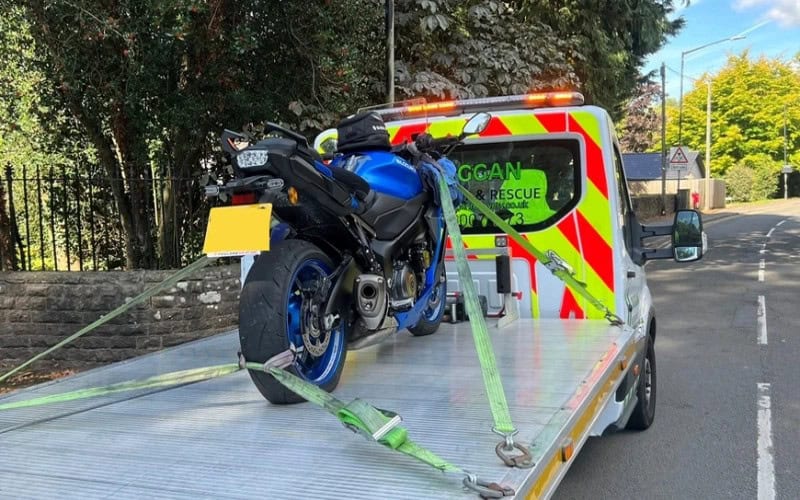
- Jump‑starts and battery assistance: Dead battery? Most providers send someone to jump‑start the bike. For motorcycles, the AMA plan tows your bike to a service facility instead of jump‑starting it. Progressive includes jump‑starts for all vehicles. (progressive.com)
- Flat tire help: Providers will either change the flat using your spare tube/tire or tow the bike to a shop. GEICO’s emergency service changes a flat with your supplied spare, while Progressive and AAA also cover tire changes. (geico.com)
- Fuel or fluid delivery: Run out of gas? Roadside assistance will deliver a few gallons of fuel so you can reach the nearest station. The delivery is usually free, but you pay for the fuel itself. Progressive notes that you pay the cost of the fuel; AMA provides fuel delivery but you pay for the gas.
- Lockout service: If you lock your keys in a saddlebag or lose them entirely, most programs will send a locksmith. GEICO covers lockouts up to $100, and Allstate’s roadside plans include lockout service in both tiers.
- Trip interruption coverage: Premium plans sometimes reimburse lodging and meals if you break down far from home. GEICO’s Emergency Road Service for motorcycles offers trip interruption benefits of $200 per day and $500 per occurrence. Allstate’s Roadside Advantage plan reimburses up to $1,500 per trip for up to three days of expenses.
Some programs bundle additional perks like concierge services, tire‑damage repair reimbursement or discounts on lodging and travel. These extras can add real value if you tour often.
Why You Need Breakdown Coverage
Breakdowns are like flat‑track racing — you don’t expect them, but when they happen you need quick reflexes. Depending on how, when and where you ride, roadside assistance can be the difference between a minor inconvenience and a major ordeal.
Touring and Long‑Distance Riders
Adventure riders and Iron Butt tourers log thousands of miles each year. They traverse remote backcountry, desert highways and mountain passes where cell service is spotty and shops are scarce. The AMA has long advocated for maintaining access to public lands (ridebdr.com), and its roadside plan covers towing for motorcycles, trailers and RVs.
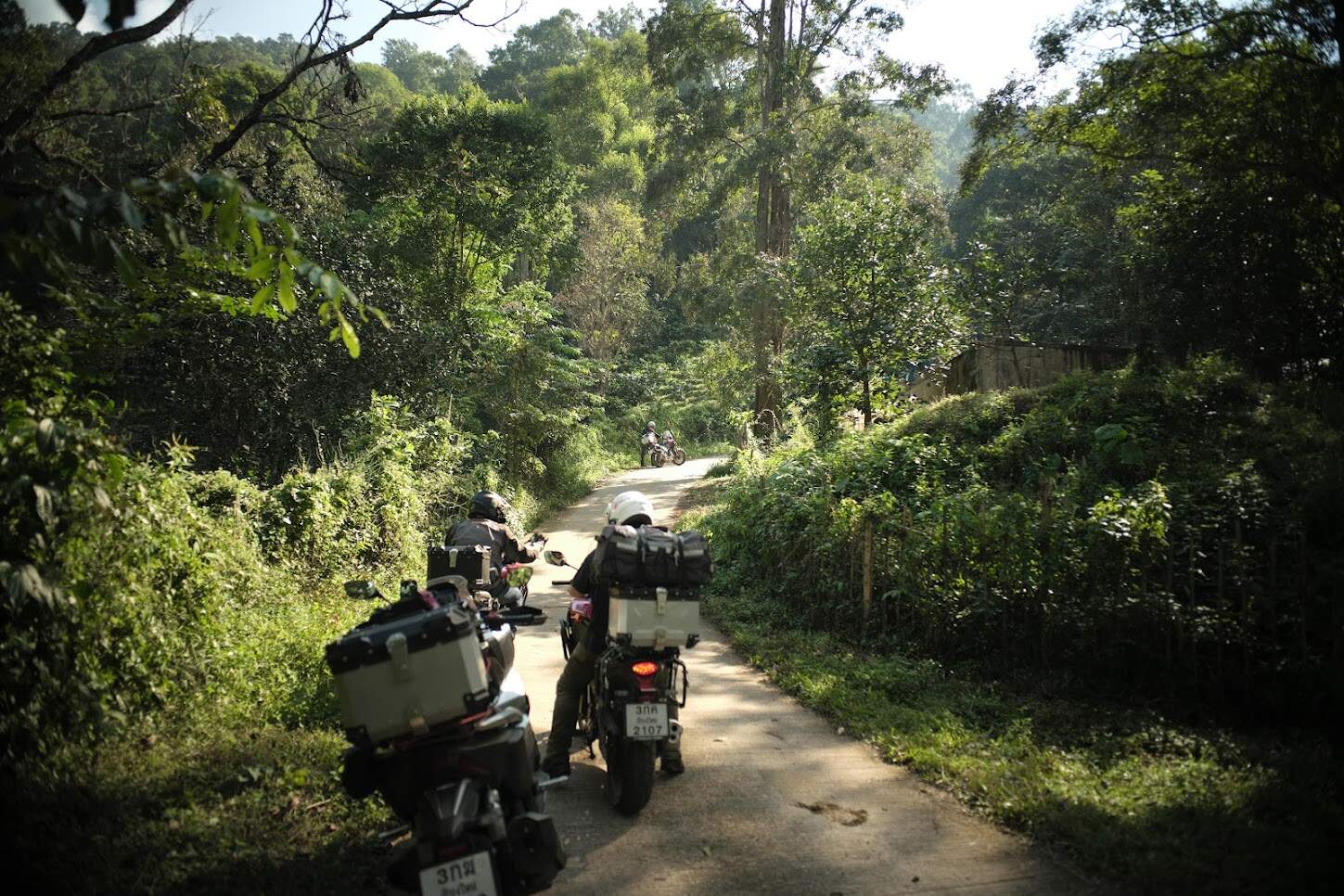
Carrying dedicated motorcycle breakdown coverage in the U.S. means that if your bike sputters 50 miles from the nearest town, you have someone to call. The AMA membership goes beyond towing—it connects you to a network of 1,200 clubs and resources on state laws and advocacy, which can be invaluable on long rides across multiple states.
Daily Commuters and Weekend Warriors
Even if you mainly ride to work or for Sunday brunch, being stuck at the office late with a dead battery or discovering a puncture on your lunch break is frustrating. GEICO’s motorcycle roadside assistance covers towing to the nearest repair facility, jump‑starts, tire changes and fuel delivery. With a plan, you won’t have to flag down a friend with a pickup truck or risk leaving the bike overnight in a parking lot. Commuters often find that an add‑on through their existing motorcycle insurance is cheap and convenient.
Occasional or Seasonal Riders
If you rarely ride, a heavy‑duty roadside membership may not make sense. Instead, you might opt for the low‑cost coverage available through your insurance provider. Many carriers charge less than $20 per year to add roadside assistance to a motorcycle policy. For instance, Progressive’s motorcycle roadside assistance can be added to a policy and includes towing within 15 miles, jump‑starts and locksmith services.
If you’re comparing roadside assistance add-ons, don’t miss our deep dive into motorcycle insurance costs and savings tips — it breaks down what riders really pay across the U.S.
Top Motorcycle Breakdown Insurance Options in the U.S.
There’s no one‑size‑fits‑all solution. Here’s how the major providers compare, along with their key benefits and limitations.
American Motorcyclist Association (AMA) Roadside Assistance
The AMA is more than a breakdown service; it’s the country’s largest advocacy group for motorcyclists. When you join or renew your membership on auto‑pay, you get the standard roadside plan for free.
The standard plan covers:
- Unlimited service calls for motorcycles and up to three calls for non‑motorcycle vehicles per year.
- Towing to the nearest qualified service facility up to 35 miles; members pay mileage over 35 miles.
- Service for motorcycles, cars, trailers and RVs — noncommercial vehicles only.
- Fuel/fluid delivery (you pay for the fuel), lockout service and a mobile mechanic for RVs.

The Plus plan adds benefits like higher towing allowances and is free for life members or about $35 per year. Beyond roadside help, AMA membership comes with advocacy and community perks:
- The association has spent 100 years defending rider access to public lands and state‑level rights.
- Members get the AMA monthly magazine, access to a database of state laws and exclusive discounts on gear and travel.
- You can join local clubs and participate in AMA‑sanctioned rides across the country.
For riders who value community and activism as much as roadside assistance, the AMA provides unmatched value at roughly $4 a month.
Progressive Motorcycle Roadside Assistance
Progressive offers roadside assistance as an add‑on to your motorcycle insurance policy. The coverage includes:
- Towing your bike within a 15‑mile radius or to the closest repair shop if farther.
- Winching within 100 feet of a road.
- Jump‑starts, locksmith services and flat‑tire changes.
- Fuel delivery; you pay for the fuel delivered.
Progressive also offers trip interruption coverage when you break down more than 100 miles from home, paying up to $500 for lodging, food and transportation. Because it’s an insurance add‑on, there’s no separate membership fee. The cost typically adds $10–$20 per year to your policy, making it a good deal for commuters and occasional riders who already carry Progressive insurance. The downside is the 15‑mile towing limit, which may not be enough for long‑distance touring. You also have no access to broader perks like gear discounts or advocacy work.
GEICO Emergency Road Service (ERS)
GEICO’s ERS is another inexpensive add‑on. It covers:
- Towing to the nearest repair facility, regardless of distance; details about mileage limits are in your policy but GEICO notes that motorcycles, boats and RVs require separate coverage.
- Jump‑starts, tire changes with your spare, lockout services up to $100, winching and fuel delivery.
- Trip interruption benefits for motorcycles: ERS provides $200 per day and $500 per occurrence for travel expenses if your bike becomes inoperable during a trip.
GEICO’s motorcycle roadside assistance is widely praised for its low cost (typically under $10 per year) and hassle‑free service. However, because towing is to the nearest facility, you may not have a say in where your bike is taken. Riders who prefer towing to a specific shop or dealership may find this limiting.
AAA Motorcycle Roadside Assistance
AAA needs no introduction; it’s the granddaddy of auto clubs. Membership is sold in tiers — Classic, Plus and Premier — and pricing varies by region. Using AAA’s Southern California membership chart as a reference, the Classic tier costs around $35–$50 per year and provides four service calls with towing up to 7 miles per call.
The Plus tier costs roughly $70–$80 and tows you up to 100 miles. The Premier tier, about $99–$130, includes one tow up to 200 miles per year plus the same 100‑mile limit on your remaining calls.
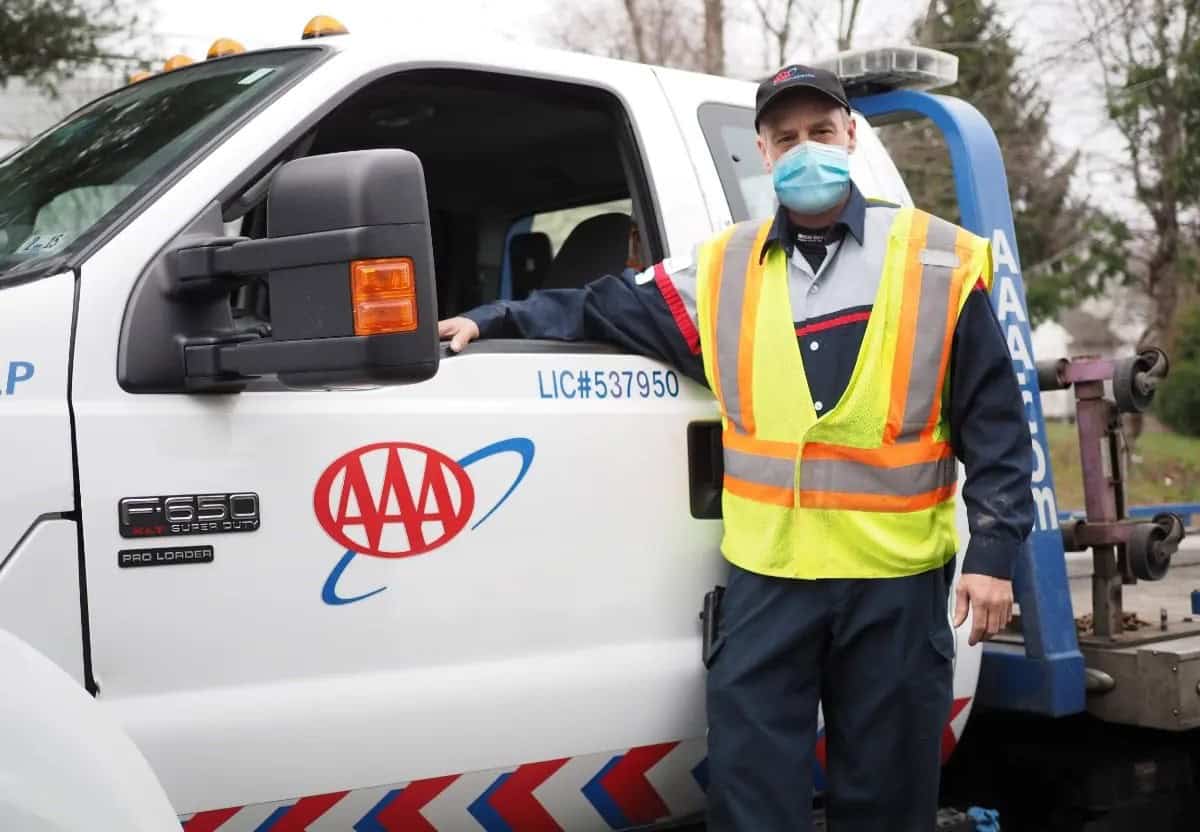
AAA’s benefits go beyond towing:
- Plus members get free emergency fuel and bigger locksmith and rental car discounts.
- Premier members enjoy added concierge services and travel planning.
- Members also receive discounts on hotels, attractions and insurance premiums.
The drawbacks? AAA charges an annual fee that can be higher than adding roadside assistance to your insurance, and its coverage often applies only to your personal vehicle. The article by Gordon Insurance notes that AAA’s benefits include travel assistance, insurance discounts and trusted service centers, but membership fees range from $50 to over $150, which may not justify the cost if you rarely need roadside help. AAA also limits assistance to registered vehicles; if you frequently ride rental bikes, you may not be covered.
Allstate Roadside
Allstate offers stand‑alone roadside memberships; you don’t need an Allstate insurance policy to sign up. The Roadside Assist plan costs about $6.09 per month (around $73 for the first year) and covers up to 5 rescues a year. Key benefits include towing up to 10 miles per call, jump‑starts, fuel delivery, lockout service and tire changes. There is no trip‑interruption coverage in the base plan.
The Roadside Advantage plan costs about $7.42 per month (around $89 for the first year) and also covers five rescues per year. It matches the 10‑mile towing limit but adds trip interruption benefits up to $1,500 per trip (three days of expenses) and reimbursement for tire repairs up to $100 per incident. Both plans allow you to cover two people and additional household members for an extra fee. For motorcycles, Allstate also sells a separate “Motorcycle and RV protection” membership with renewal pricing around $78–$105 per year.
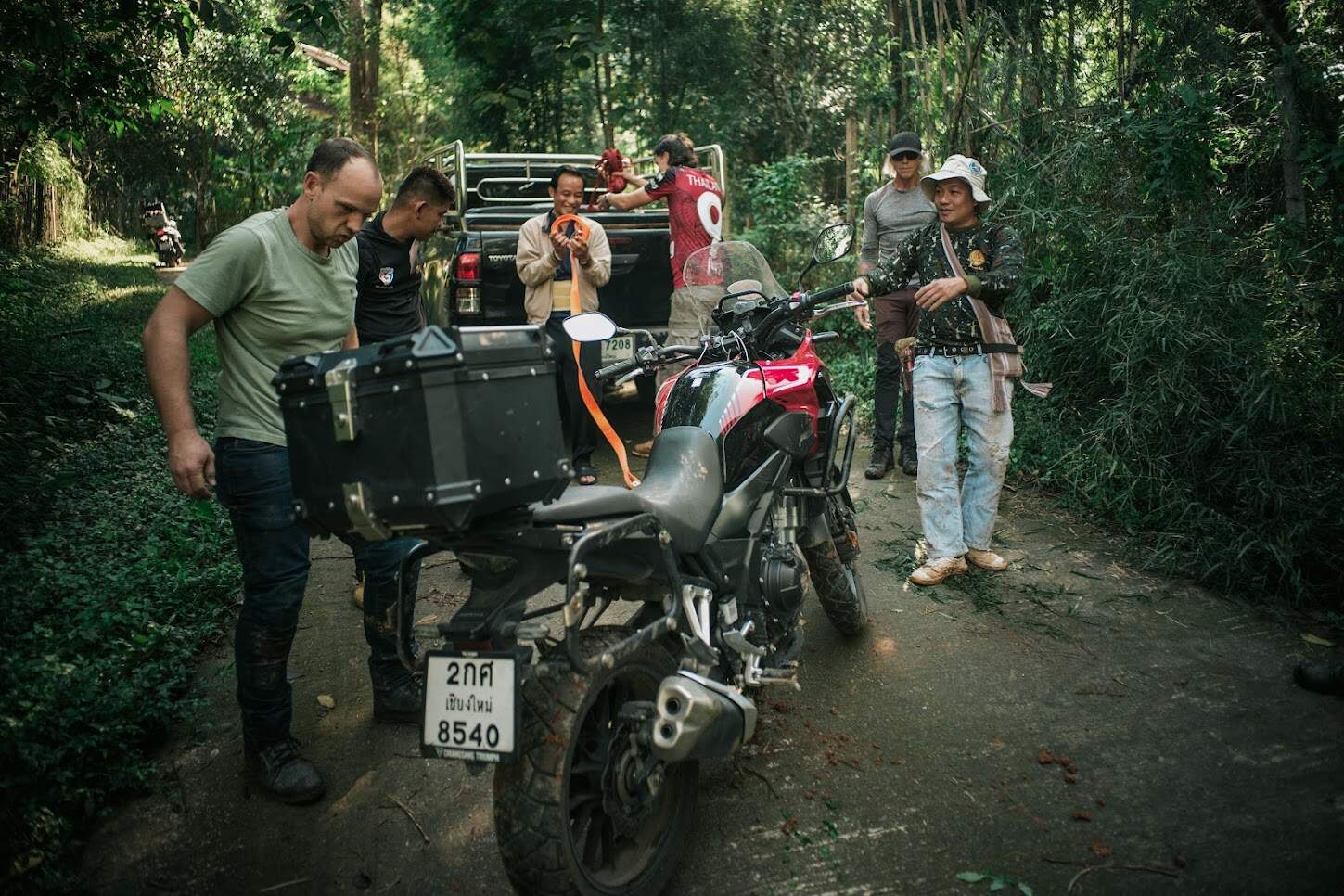
Pros: Allstate plans are available nationwide, you get 24/7 coverage whether you’re the driver or passenger, and you can join without purchasing Allstate insurance. Cons: The 10‑mile towing cap is restrictive; beyond that, you pay per mile. The number of service calls (five per year) may be limiting for frequent riders. Riders who venture far from home or expect longer towing distances might be better served by AMA or AAA Plus/Premier plans.
Other Notable Options
- State Farm Roadside Assistance – Includes towing to the nearest repair facility and covers labor for jump-starts and flat tires, though it does not offer trip-interruption coverage.
- USAA Roadside Assistance – Available exclusively for military members and their families. Offers affordable plans with generous towing limits and trip-interruption benefits.
- BMW Motorcycle Owners of America (MOA) – Memberships include optional roadside assistance coverage, often extending to Canada and international travel.
Stand‑Alone vs. Bundled Roadside Insurance
One question every rider faces is whether to purchase a standalone roadside membership like the AMA or AAA, or simply add roadside assistance to an existing motorcycle insurance policy. Both have pros and cons.
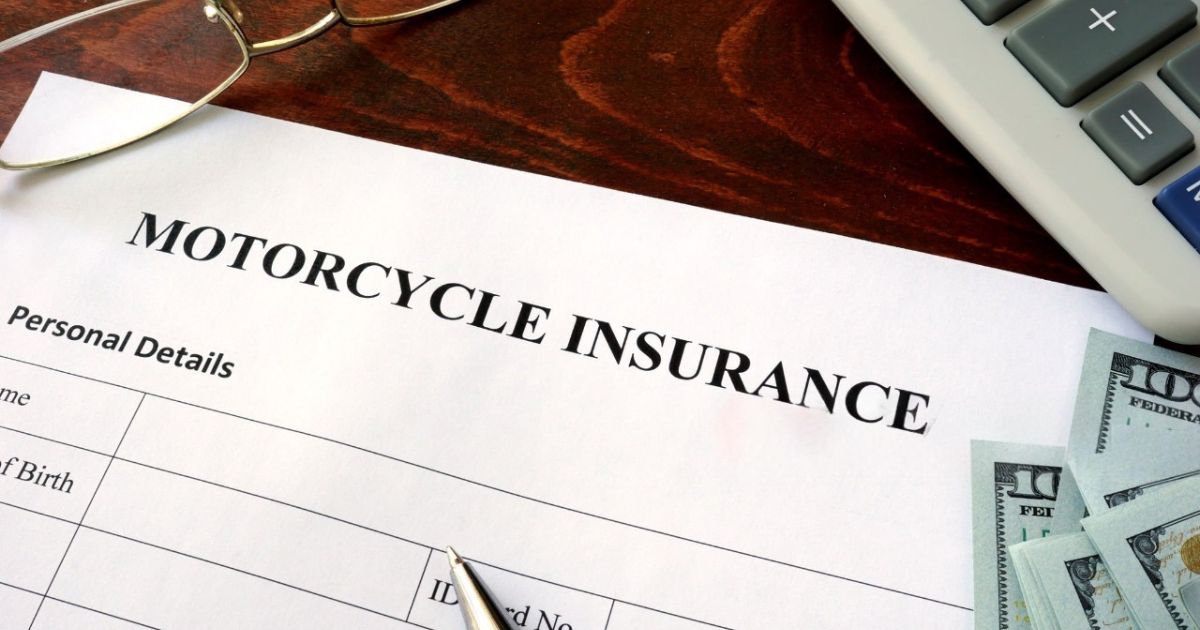
Advantages of Stand‑Alone Plans
- Broader Coverage: Stand‑alone memberships often cover multiple vehicles — motorcycles, cars, trailers and RVs. The AMA plan covers up to five vehicles and provides unlimited motorcycle calls.
- Longer Towing Distances: AAA Plus/Premier and some specialized motorcycle clubs offer 100–200 mile tows, far beyond the 15‑mile radius typical of insurance add‑ons.
- Extra Perks: Memberships may include travel discounts, advocacy, magazines, training and community events. AMA members gain access to advocacy programs and local clubs.
- No Insurance Claim Impact: Since stand‑alone calls aren’t filed with your insurer, they won’t affect your claims history or premiums.
For riders managing multiple bikes who want cost-efficient insurance models, be sure to also check out our article on pay-per-mile coverage.
Advantages of Bundled (Insurance) Add‑Ons
- Cost‑Effective: Insurance add‑ons are usually cheaper, often $10–$20 per year, which is far less than many membership fees.
- Convenience: Having all coverage under one company means a single bill and fewer accounts to manage. The Gordon Insurance article notes that integrating roadside assistance into your auto insurance simplifies billing and management. (gordoninsurancellc.com)
- Adequate for Short Trips: If you ride mostly within city limits or commute, the towing distances offered by insurers (5–15 miles) may suffice.
Drawbacks to Consider
- Towing Distance Limits: Insurance add‑ons typically cap towing at 10–15 miles. If you break down farther away, you pay the extra mileage. Stand‑alone plans like AAA Plus or AMA may be better for touring riders.
- Number of Service Calls: Allstate limits you to five rescues per year, while AAA Classic allows four. Heavy travellers might burn through these quickly.
- Reimbursement vs. Direct Service: Some insurers require you to pay upfront and seek reimbursement. Make sure your plan provides sign‑and‑drive service where the provider pays directly.
- Vehicle Restrictions: Check whether motorcycles are included. Many car‑centric plans exclude bikes unless you add a separate endorsement.
- Membership Fees: Stand‑alone clubs can cost $50–$150 per year. You’re paying for perks beyond roadside help; decide whether you’ll use them.
How to Choose the Right Breakdown Coverage for Your Needs
When choosing a motorcycle breakdown cover USA plan, consider these factors:
- Riding Habits: How far and how often do you ride? Long‑distance tourers should prioritize programs with generous towing distances and trip‑interruption benefits, such as AMA Plus or AAA Premier. Commuters may opt for inexpensive insurance add‑ons.

- Number of Vehicles: If you own multiple bikes or have cars, trailers or RVs, look for a plan covering all of them. AMA covers up to five vehicles; Allstate allows adding household members for a fee.
- Budget: Balance cost against benefits. For around $10 a year, Progressive or GEICO add‑ons may suffice. If you value advocacy, travel discounts and long tows, paying $4 per month for an AMA membership might be worthwhile.
- Service Area: Check whether coverage is nationwide. Most national carriers cover the U.S. and Canada, but some regional clubs have limited areas.
- Trip Coverage: Do you take multi‑day rides? Plans with trip interruption (GEICO ERS, Allstate Advantage, Progressive, AAA Premier) reimburse lodging and meals when you’re stranded.
What to Watch Out For
- Fine Print on Distance: The headline towing distance may only apply per service call. Progressive’s 15‑mile radius and Allstate’s 10‑mile limit can leave you paying extra if the nearest shop is farther away. AAA Plus covers 100 miles per call but only four calls per year.
- Service Call Caps: Many plans limit how many times you can call in a year — five calls for Allstate, four for AAA. If you ride frequently or have multiple vehicles, ensure your plan offers enough calls or unlimited service like the AMA’s plan for motorcycles.

- Reimbursement‑Only Plans: Some providers reimburse you after the fact instead of dispatching help. Look for “sign‑and‑drive” language so you aren’t stuck paying out of pocket.
- Excluded Scenarios: Most roadside plans don’t cover off‑road rescue. If you adventure off the beaten path, consider supplemental travel or rescue insurance like Global Rescue, which the AMA partners with.
- Policy or Membership Eligibility: Many insurance add‑ons require you to insure your bike with the company. Stand‑alone memberships typically don’t.
Final Thoughts: Peace of Mind When Things Go Sideways
As riders, we love the freedom of the open road but hate surprises that leave us stranded. Motorcycle breakdown insurance isn’t glamorous — there’s no shiny gear to unbox or horsepower to brag about — but it can make or break a ride.
Whether you opt for the AMA motorcycle roadside assistance with its advocacy and community benefits, choose a Progressive motorcycle roadside assistance add‑on for a few bucks per year, rely on GEICO motorcycle roadside assistance with its trip‑interruption perk, or spring for AAA or Allstate, the goal is the same: keeping your ride moving and your stress low.
Take an honest look at your riding habits, budget and travel plans. Don’t assume the plan that works for your car will automatically cover your bike. Read the fine print on towing distances, service call limits and reimbursement policies. And remember that membership in organizations like the AMA supports the rights of motorcyclists, giving you a say in the future of the sport while also protecting you on the road.
Ride prepared, ride happy, and may your motorcycle breakdown insurance never actually be needed.
Related
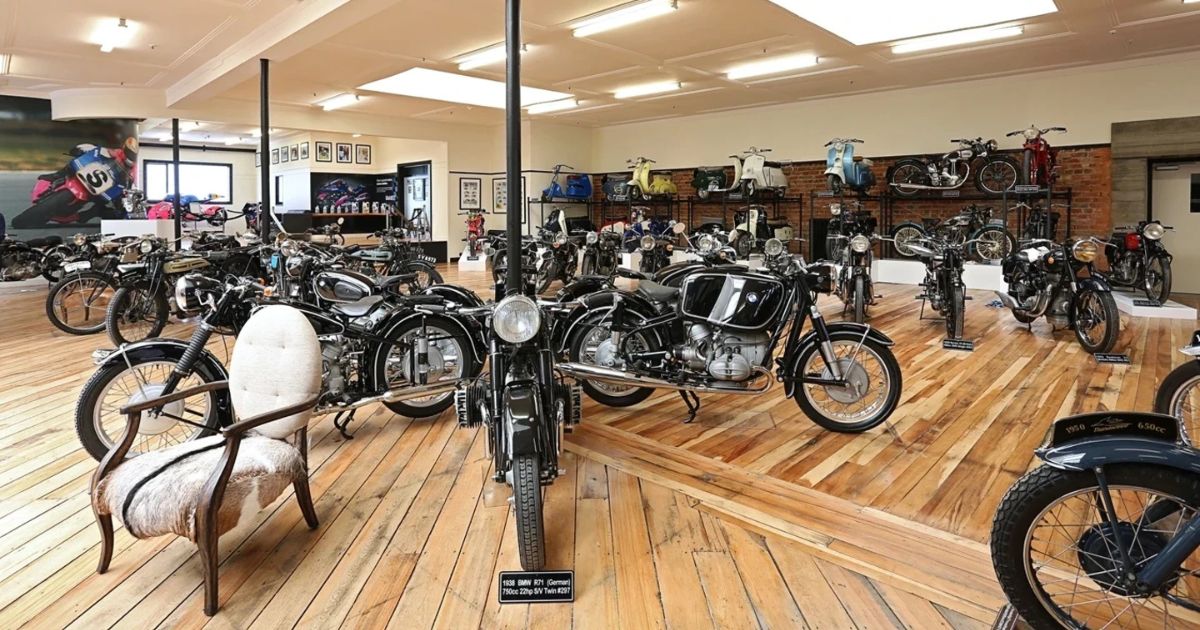
Classic Motorcycle Insurance: Protect Your Ride’s Legacy
If your ride’s got history, it deserves protection to match. Classic motorcycle insurance keeps legends alive and riders worry-free.


